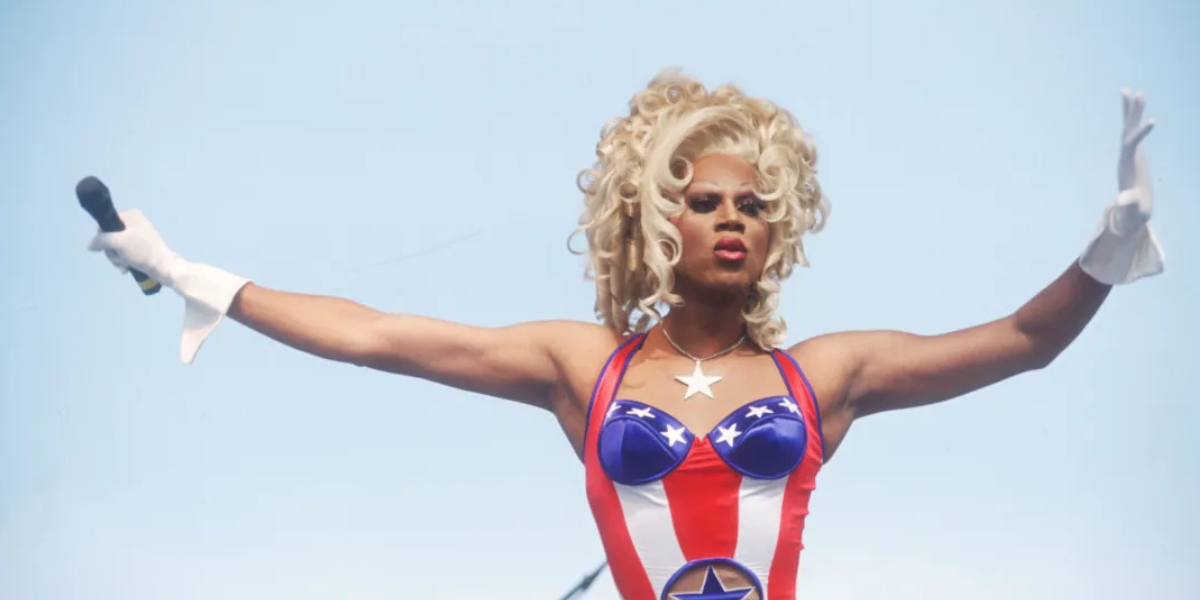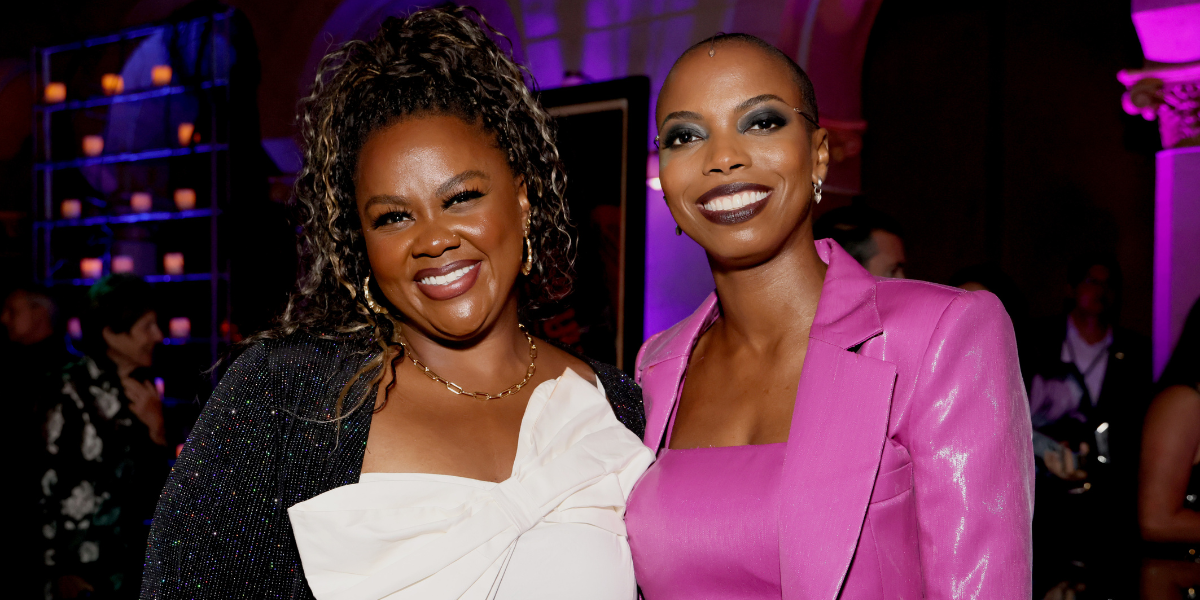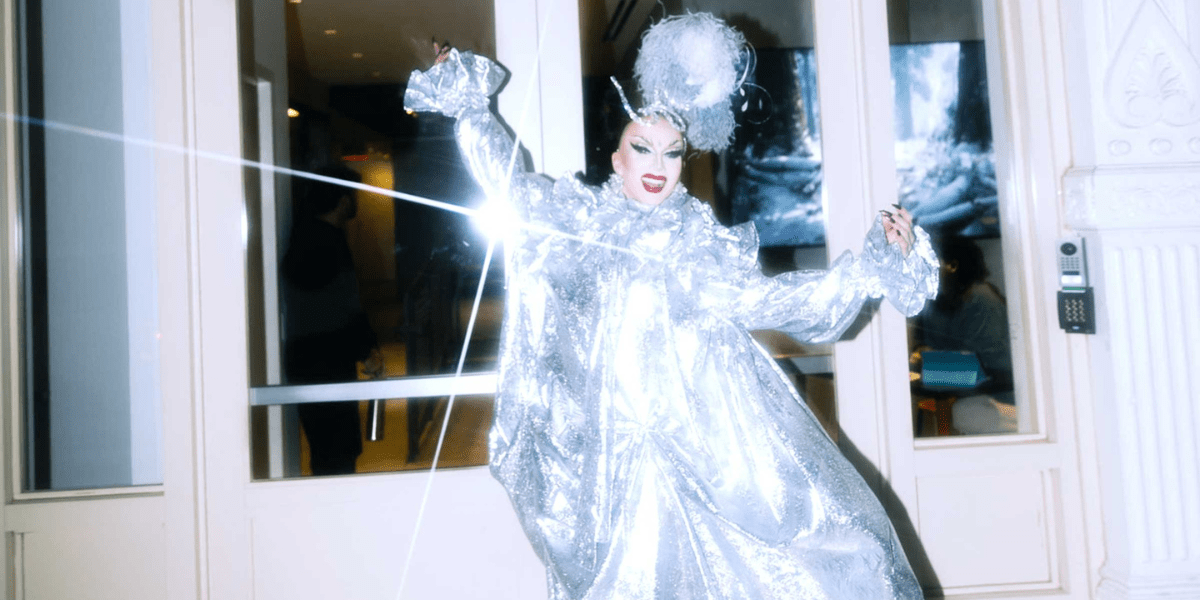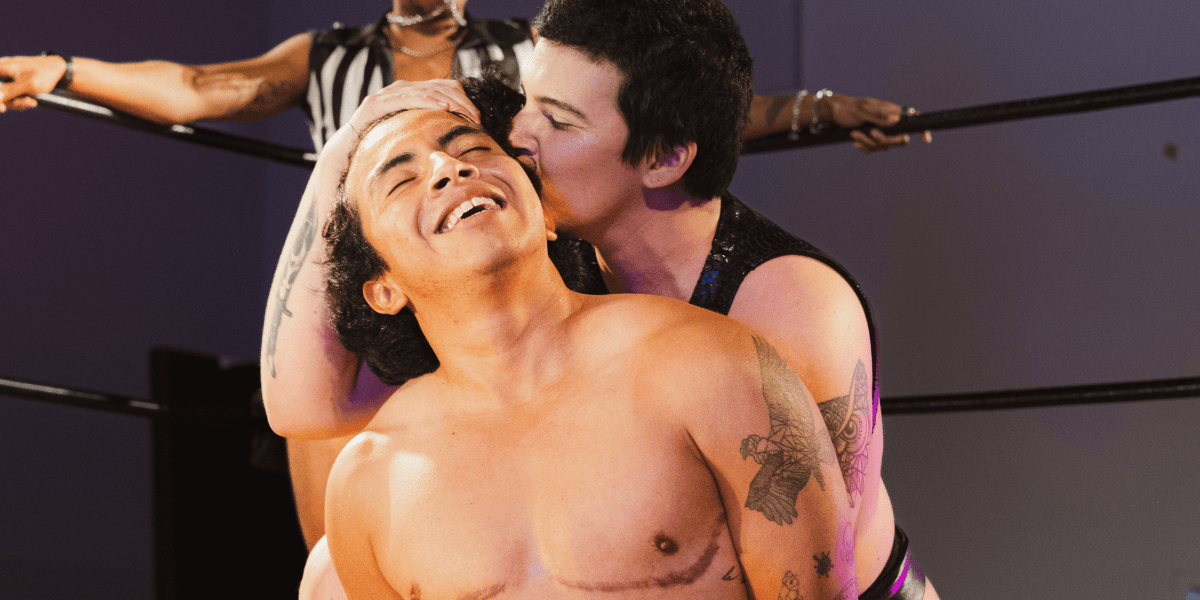Happy Lesbian Visibility Day! To celebrate let’s all be invisible inside our own homes. Last year on this very day, we posted a roundtable about what part of lesbian history/community we were most proud of. The year before that, we published a roundtable asking our writers who identify as lesbians to talk about why they chose that label and how it affects the way they move through the world!
This year not all of our writers who identify as lesbians were able to participate because ~waves hands wildly~ the world, but we got a solid chunk of us to answer a question everybody was very excited about: What is in your lesbian canon? What books, movies and music do you consider essential lesbian material and/or lesbian art that is essential to your own understanding of your identity? And also: What’s missing? What representation would you like to see of lesbians in art and media that you don’t see enough of?
Heather Hogan, Senior Writer
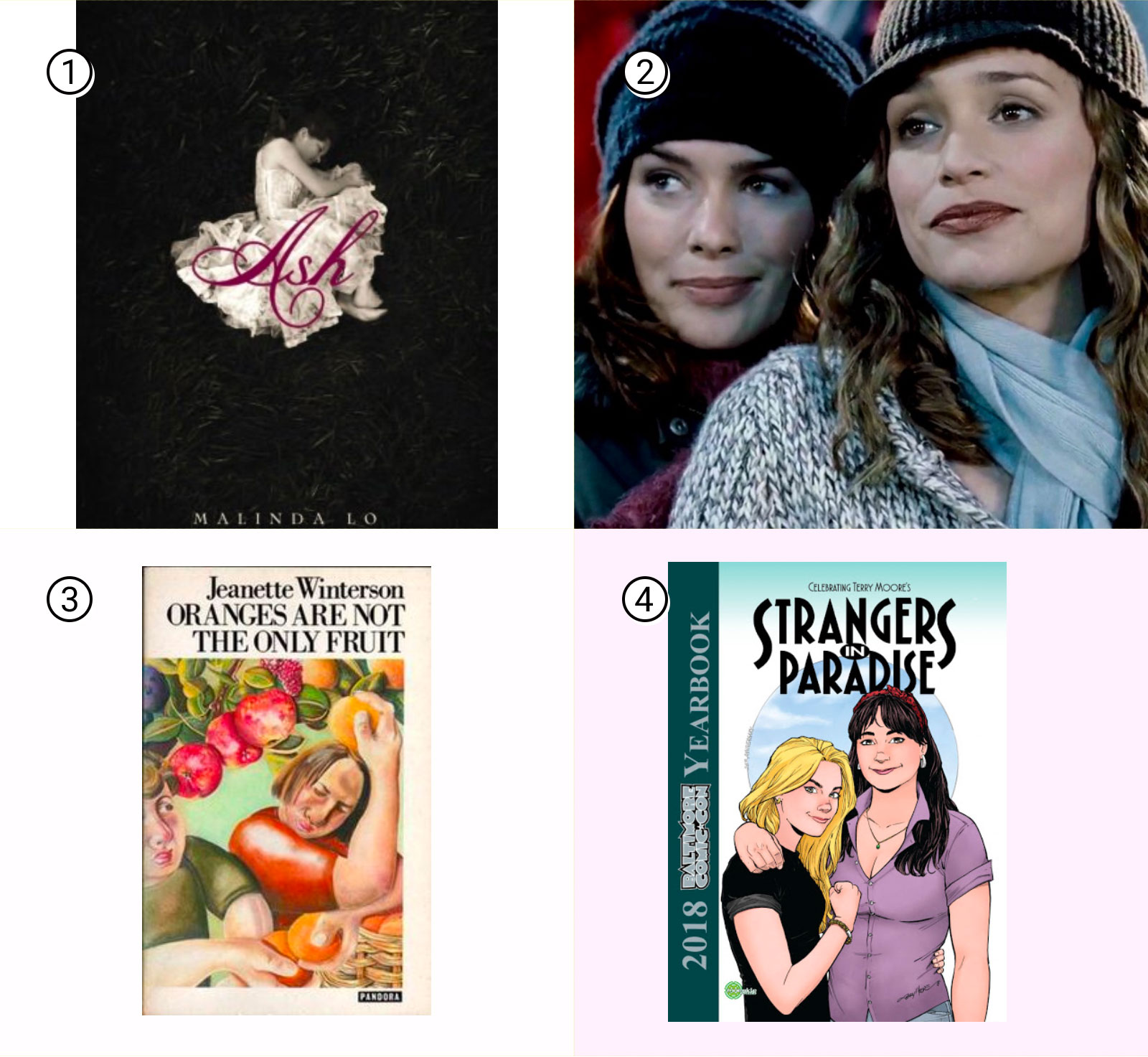
I can’t speak for what is or should be in THE lesbian canon, but I can speak to my specific rural southern ’80s childhood lesbian canon, followed by my rural southern ’90s teenage lesbian canon, followed by my ascent into professional lesbianism. For me, the writing is: Oranges are Not the Only Fruit, by Jeanette Winterson, Ash by Malinda Lo, Fun Home by Alison Bechdel, Strangers in Paradise by Terry Moore, and every poem Mary Oliver ever wrote. That’s a perfect mix of “I love Jesus too much to be a soft butch homosexual in this small town where my relationship with my mom is building a mystery of trauma that’s going to last a lifetime; maybe I’ll just go outside in nature and breathe and grieve and be grateful and think about fairy tales.” For movies, I’ve got two categories: coming out/of age and lesbian misandry. For the first, Saving Face, D.E.B.S., Desert Hearts, and Imagine Me & You; for the second, Battle of the Sexes and Carol. You’d think TV would be the hardest for me, but honestly, it’s not. The Puppy Episodes of Ellen, Bad Girls series one through three, Skins series three and four, Great British Bake Off, and Gentleman Jack. “I’m not as strong as you think. Well, I am obviously. But. Sometimes I’m not.” Thank you, United Kingdom, for making me gay!
Dani Janae, Contributor
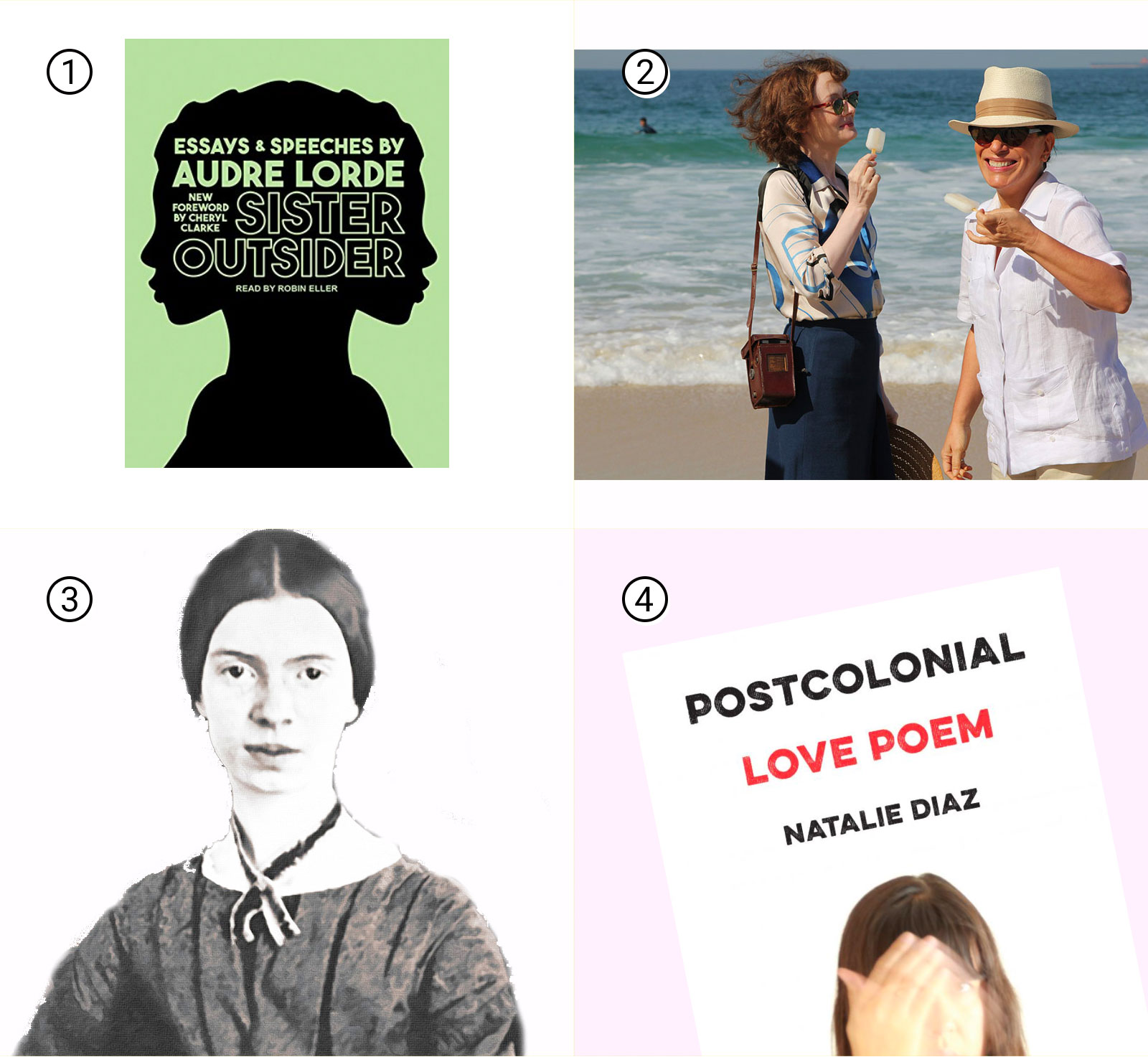
Wow wow wow I love this. There was a period online not too long ago where lesbian got treated as a bit of a bad word, and it made me so sad because I love being a lesbian, I love that identity. I identified as bi for a number of years and while its fine for other people, for me it was a stepping stone to get to lesbian. Okay enough ranting, what’s in my canon? Lots of Jeanette Winterson. I have a friend that I just exchange Jeanette Winterson quotes with and it is glorious. Her meditations on adoption resonate so deeply with me and made me see myself in that way for the first time. I specifically think of her memoir, Why Be Happy When You Can Be Normal and of course Oranges are Not the Only Fruit. The first time I read Oranges I had just ended a thing with a woman who was closeted and not nearly ready to come out and it made me weep. I also have Sister Outsider by Audre Lorde, everything by Adrienne Rich and Elizabeth Bishop, Natalie Diaz, and Emily Dickinson. Poets taught me about love, poetry was my first love and so when I want to read I naturally gravitate toward lesbian poets.
For TV/Movies I find myself really coming hard with the original L Word. I saw it at a pivotal age and it was the first time I realized two women could have a life together. One lowkey deep cut movie I’ve always loved was the movie about Elizabeth Bishop, Reaching for the Moon. If you can’t tell by the recent things I’ve written I’m all about lesbianism and poetry, and when those two things collide I explode. I recently finished the first season of Feel Good and it devastated me. Desert Hearts and Pariah and Moonlight also are a part of this canon for me. But, one figure that has been very central to my lesbianism is Queen Latifah. I’ve been in love with her for years and every time new pictures of her emerge I feel this joy bubble up inside me. She was the first plus-size woman I saw as a love interest on TV and movies and that meant the world to me.
In the present and future, I’d love to see more fat lesbians, lesbians struggling with addiction, broke lesbians, lesbian sex workers. There’s so much I want and I feel like I get a little bit of it at a time, so there’s progress being made but there’s still a long way to go.
Kayla Kumari, Writer
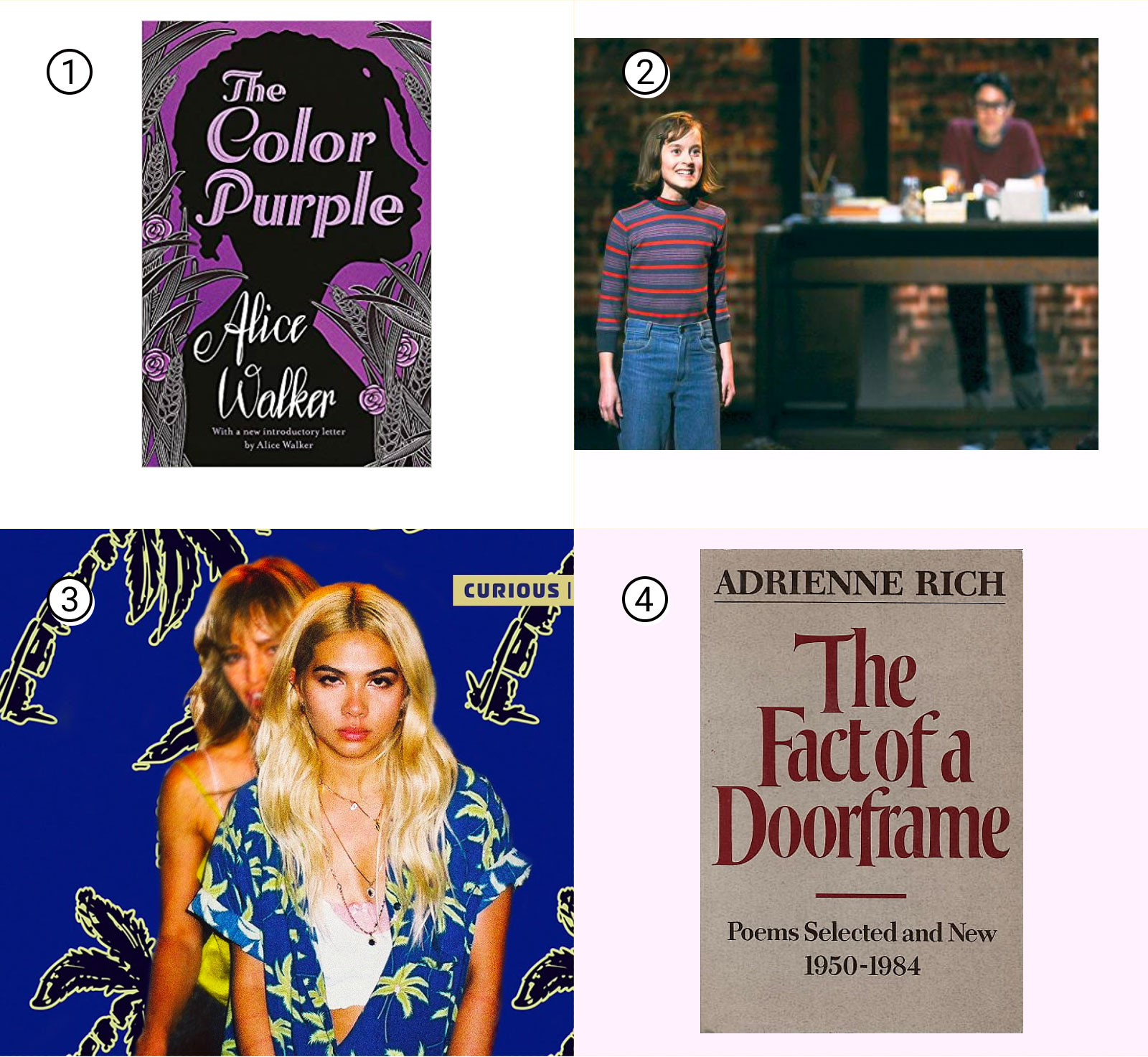
I love being a lesbian, and I love lesbian art!!!! My personal lesbian canon through the years includes but is certainly not limited to: The Color Purple by Alice Walker, The Price Of Salt by Patricia Highsmith, Cheryl Dunye’s body of work, The Fact Of A Doorframe by Adrienne Rich, the book and the film The Hours, YES: THE L WORD, Dykes To Watch Out For by Alison Bechdel, Fun Home the musical and specifically “Ring Of Keys,” Fingersmith and The Handmaiden, Hayley Kiyoko music videos, Saving Face, Long Live The Tribe Of Fatherless Girls by T Kira Madden, But I’m A Cheerleader, the fictional character Elena Alvarez, Spinning by Tillie Walden…etc! I’m sure I’m forgetting some, but all of that art has been in some way formative for me at some point, and my personal canon is always evolving.
I’m literally always craving more representation of South Asian lesbians. Like literally a crumb of it. Please. Honestly, I kind of consider Bend It Like Beckham to be part of the lesbian canon of my life even though it’s all in the subtext. Sometimes I gotta settle for subtext!
Kamala Puligandla, Deputy Editor

I have been recently going back to some of the cannon that got me started on my queer journey in my early college years, and it’s always in places where I least expected to find queerness that I found it the most thrilling, like it proved to me that it was something totally regular that you might just encounter in the wild. I’m thinking about Basic Instinct, Showgirls, Gia, Bound — though I think I actually watched that one because my best friend couldn’t stop talking about how hot Gina Gershon was. It’s really funny to me that these tiny moments in movies that always portrayed queerness as a weird side note, still were the ones that left such a huge positive impact on me. I also remember going to Frameline festivals and then seeing movies about actual queer adult women, like Saving Face , which my mom brought me to, and understanding that being a lesbian could be a main storyline, and that it was a lot more exciting that way! I feel very at home in my womanhood and am obsessed with and fixated on women, so I’ll call myself a lesbian, but the media that most spoke to me about my gender and sexuality when I was coming of age, my own personal queer cannon, were things like Paris is Burning, To Wong Foo, Thanks For Everything! July Newmar, Purple Rain, Female Trouble, Party Monster, disco and early house music, and the writing of bell hooks, Audre Lorde, Remedios Varo, Reinaldo Arenas, Justin Chin, David Sedaris, Federico Garcia Lorca, Hanif Kureishi — there were stellar women, but also a lot of queer men who taught me to cherish the flexibility of my own femininty, and to embrace its vulnerability as power.
The main thing I want to see more of in lesbian art and media is lesbians not being tragic figures and not being heroines, but just being regular people. I want to see lesbians of color having a really great time together. And I want to see them doing things lesbians would find particularly fun: cleaning out the fridge, shopping for handmade mugs, giving hand massages while rolling on molly, hanging a whole bunch of art on the wall, making fun of all the straight people in their family, talking heatedly about books that are changing them, talking about what they learned in their doula workshop, making the most elaborate picnic in the world to impress another lesbian who has also made the most elaborate picnic in the world, singing along to My Neck, My Back.
Sally, Contributor
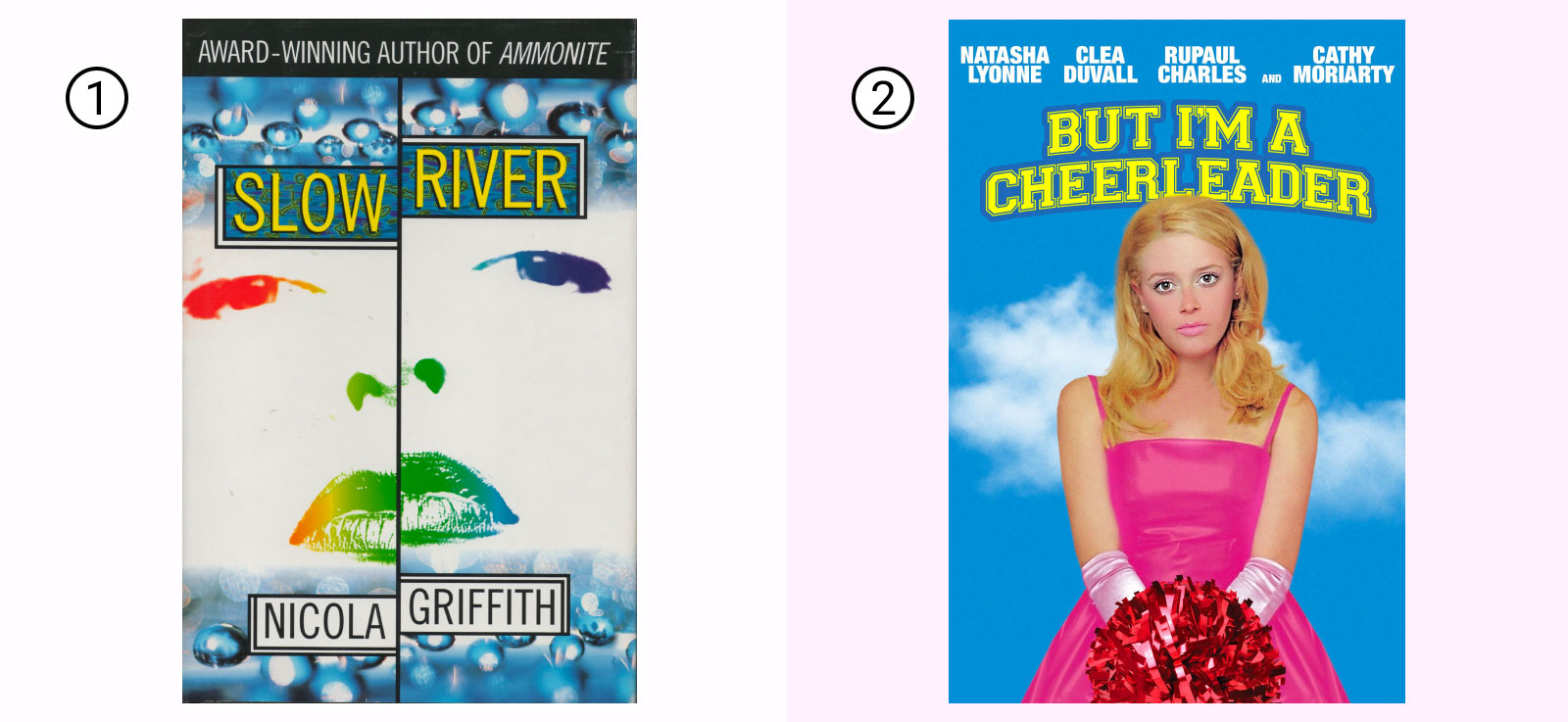
Growing up before the internet was an omnipresent crutch, my first experiences with lesbian media usually came after lengthy hunts through libraries and book shops or scouring magazines and TV listings. I was looking for the lesbian semiotics that might signal something worth pursuing: does this book’s publisher sound like a bitchy Greek goddess? Does that show have enough female cast members that statistically one of them has to be gay?
Needless to say, results were mixed, but it did help me develop an abiding fondness for things that are a bit crap. So, on the one hand it may be fair to say my true lesbian canon is a smattering of dreary lesbian feminist melodramas, underwhelming crime novels and the entire sorry oeuvre of Nicole Conn. However, the following were a slightly more positive influence, that I would be glad to put in my canon:
Film: But I’m a Cheerleader. This was the first film I saw that defied the tropes of lesbian misery and earnestness, and quite possibly the first ever lesbian film that was actually fun. I saw it on the UK release in 2001, at a time when I was obsessed with John Waters, and I was delighted that lesbians could get in on the same campy and surreal antics as the gay boys.
Book: Slow River by Nicola Griffith. I found this at my local library, the first book I read that combined sci-fi and lesbians (and sex), which had a profound and lasting effect! Other books by Griffith, like the Aud Torvingen series, really crystallised the archetype of strong, badass lesbians for me.
TV: Bad Girls. I can’t really attempt to better Heather Hogan’s description of this series. However, as a representative of the United Kingdom, I am happy to accept Heather’s thanks for making her gay.
There’s two kinds of representation I’d love to see more of, which are more and less lesbian-specific. The less specific one is friendship between lesbians (and more queer people in general). While it’s great that every show on American/British TV seems happy to chuck a gay character into the cast these days, too often it just seems like it’s one person surrounded by a bunch of straight people. We don’t see gay community. Show us trans lesbians and cis lesbians hanging out with each other and supporting each other, and bisexual women and non-binary people. To do so you’ve got to cast all of those people, not just one.
The second is showing us lesbianism can be a concrete and unswervable thing. Queer has never fit me, or fluid; I’m curious about many things, but I’ve never needed to be about my sexuality. Discussion around this has got distorted by shitty people and their “gold star” obsessions, but when you strip out that weird crap, there’s a bunch of people for whom it’s just a fact that they’ve known they were very, undeniably gay since their most formative years, and it’s influenced a lot about their identity. Until Anne Lister popped onto our screens in Gentleman Jack last year, I don’t recall any other lesbian character that had such blazing certainty around her sexuality. One who I did not have to worry about having a drunken tryst with a guy followed by an interminable pregnancy plot. Those stories may be valid, but they seem disproportionate, and for sure they aren’t mine.
Drew Gregory, Writer
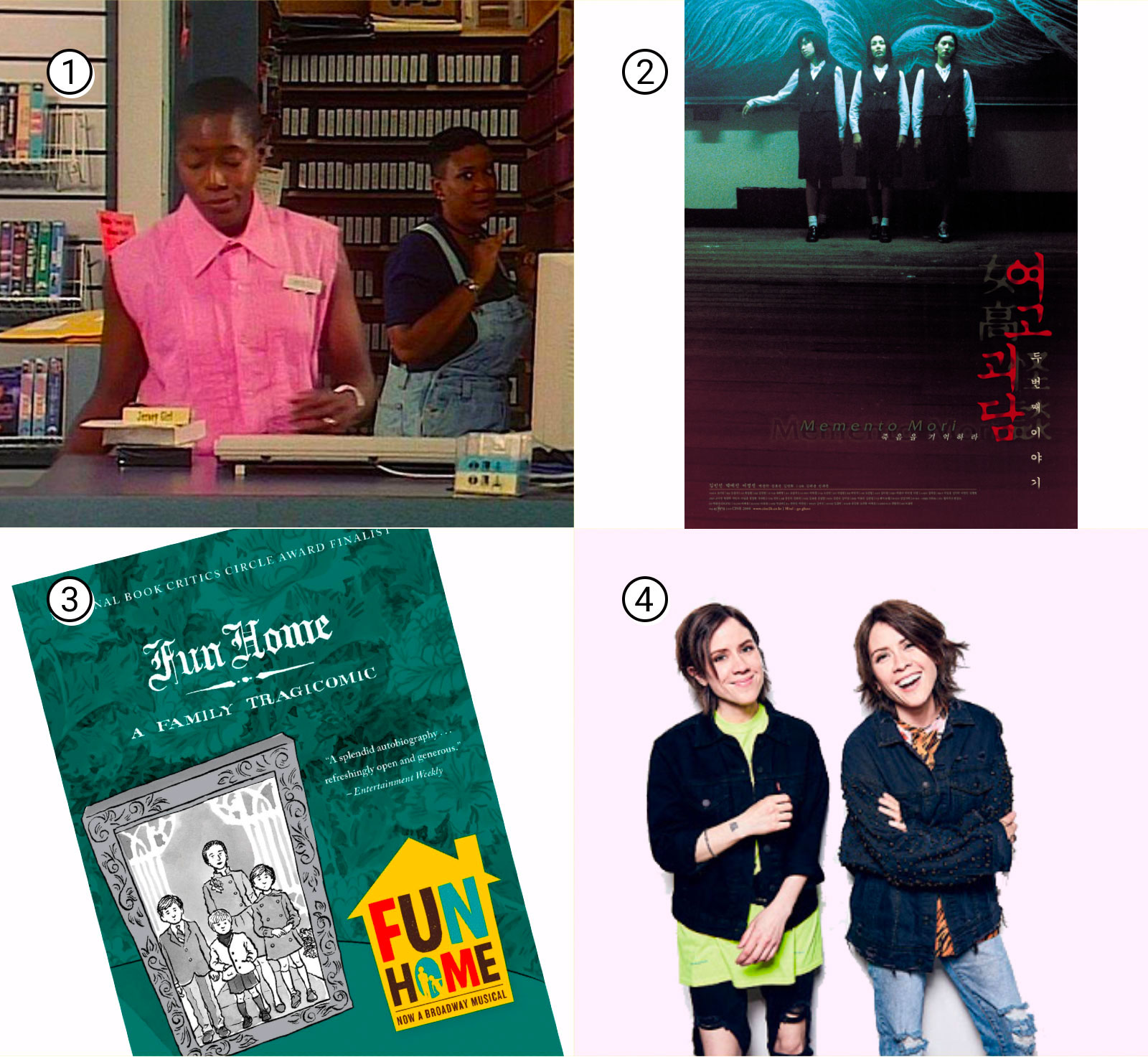
The question of what’s in my lesbian canon can be answered by the question what’s missing. My favorite lesbian movie of all time — and simply my favorite movie of all time — is Cheryl Dunye’s The Watermelon Woman. This was one of my favorite movies before I came out and my adoration only grew once I understood my connection to it. Dunye’s first feature is a semi-autobiographical semi-mockumentary about a filmmaker named Cheryl who is researching a Black actress from the 30s known as the Watermelon Woman who was rumored to be in a relationship with her white female director. As Cheryl does this research, she begins her own relationship with a white woman played by Guinevere Turner. As a white trans woman who has never lived in Philadelphia and was only two when the movie was released, my connection to the story is obviously not direct. But what I relate to so deeply is the searching Cheryl — the filmmaker and the character — embarks upon. She’s looking for herself in the history of cinema and the history of the world. She needs this to settle in her identity, to navigate her romantic relationships and her friendships. Her ultimate conclusion that sometimes you have to create your own history is my ultimate inspiration.
But while I work on a bunch of scripts about trans lesbians, discover lost cinematic treasures that do exist, and try to lift up contemporary work from voices oft-ignored, I also take a lot of comfort in The Lesbian Canon. There is so much art that I guiltily loved — or didn’t let myself experience — before coming out that I can now live within. Fun Home, The L Word, Tegan and Sara, these sort of obvious cultural touchstones of lesbianism act as a communal second language and give me such a feeling of belonging. The last six months I finally got around to reading Rubyfruit Jungle and The Price of Salt and I was delighted by the closeness I felt to both books. It was a reminder of the importance of my lesbian identity even if I differ from the characters across other identity lines.
Also, because I’m me, I keep a personal lesbian+ film canon of 25 films that I often replace and rearrange. I don’t distinguish between lesbian/bisexual/queer because while the word lesbian is important to me, it’s messy assigning labels to fictional characters. Anyway! Here’s that canon: 25. Blue Gate Crossing, 24. The Children’s Hour, 23. Dirty Computer, 22. Memento Mori, 21.The Miseducation of Cameron Post, 20. Olivia, 19. Manji, 18. D.E.B.S., 17. Dyketactics, 16. In Between, 15. Set Me Free, 14. Je Tu Il Elle, 13. Fucking Åmål, 12. Mädchen in Uniform, 11. Princess Cyd, 10. Pariah, 9. All Over Me, 8. Multiple Maniacs, 7. But I’m a Cheerleader, 6. Carol, 5. Bound, 4. Portrait of a Lady on Fire, 3. Saving Face, 2. Desert Hearts, 1. The Watermelon Woman
Riese, Editor-in-Chief
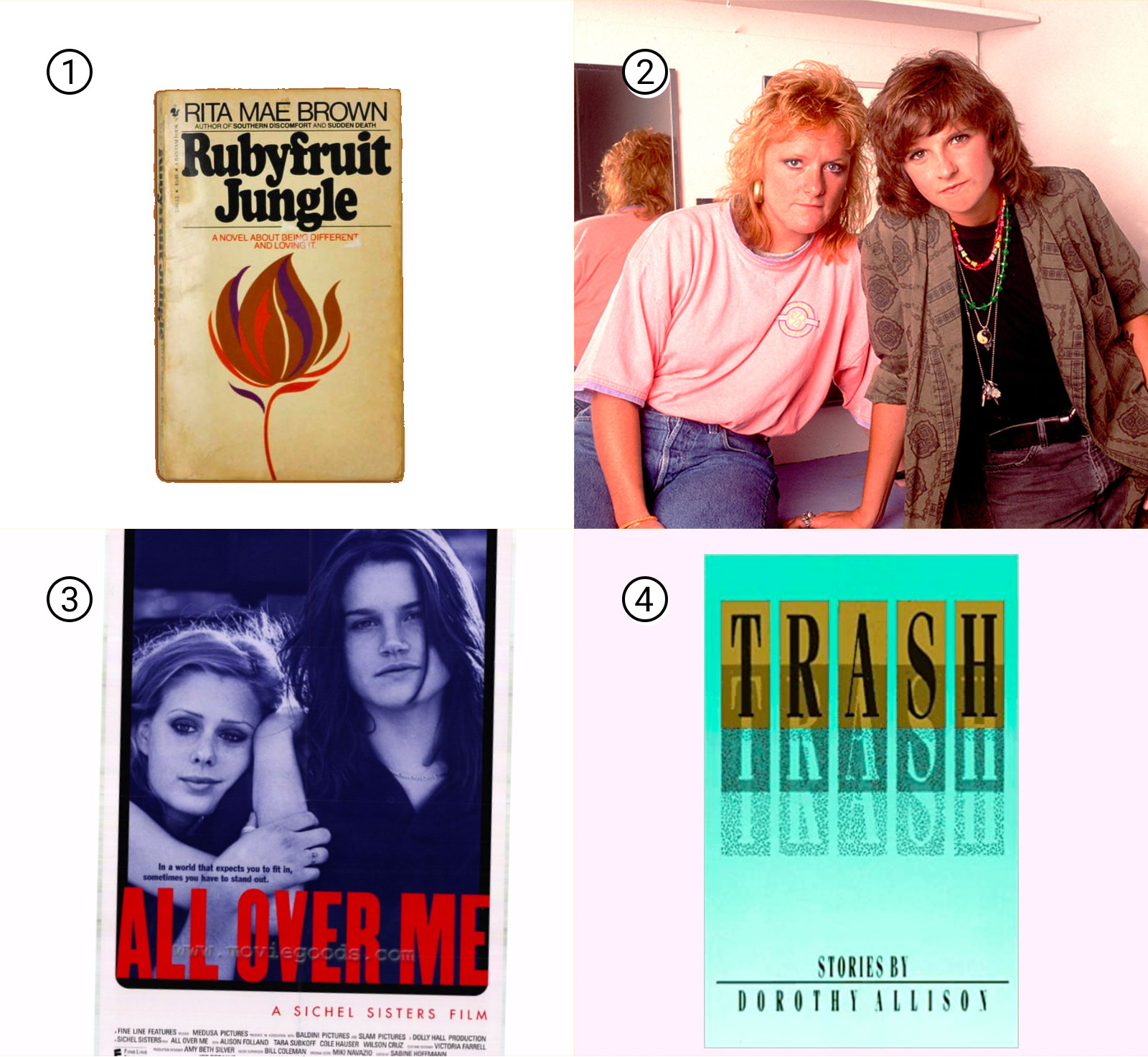
I feel like my canon is work I associate with the very beginning. Sometimes even before that. You know, like… the lesbian culture I liked before I knew it was my culture, too. Like in1995 when Lorn Merrell told me All Over Me would make me wish I was a lesbian, and I thought “fat chance,’ and then we all piled into the arthouse theater downtown to see it and I never stopped thinking about how casually Ellen came home to Claude that night. Or Gia, that we rented at boarding school and never returned. Like Foxfire, which felt like it’d been made just for me specifically. Angelina Jolie and Jenny Shimizu’s behind-the-scenes relationship in Foxfire. Or But I’m a Cheerleader, in a packed theater with a childhood friend who’d been dating a girl — maybe the first truly good and very lesbian movie I’d seen. Those films wedged their way into me and it just took a little time to figure out why. The Indigo Girls, too. The Indigo Girls were the first lesbians I knew existed, and their concerts were the first mostly-queer spaces I ever visited. They’ll always be my favorite, always.
Once I figured out I was gay I did, as so many of us do, intentionally set out to read and watch what I understood to be the lesbian canon: Well of Loneliness, Oranges Are Not The Only Fruit, Annie on My Mind, etc etc. Some stood out: I think Rubyfruit Jungle was the first lesbian novel I read that felt like a true joy to read, that made me excited to be a lesbian. I was delighted how easily Molly got the girl every time. Tipping the Velvet was such a rich story I related to intensely, and it opened up the possibility that our stories started longer ago than I’d thought possible.
I fucking love history, and knowing where we came from has been central to my understanding of what comes next. Odd Girls and Twilight Lovers was a great introduction to U.S. lesbian history, The Girls Next Door covered some compelling niches of the ’90s. The Sewing Circle, a soapy treat about lesbianism in early Hollywood, from which I learned a lot. One of so many things missing in all this is how entirely focused the aforementioned are on white cis women. Zami: A New Spelling of My Name isn’t a history book but I still learned history from it.
Everything by Dorothy Allison but especially Trash and Two Or Three Things I Know For Sure. Everything Eileen Myles says and/or does and/or writes. The way Mary Gaitskill writes about sex and sexuality and sex work. The lesbian liaisons in A.M Holmes‘ suburbia. Rick Moody’s novella “The Ring of Brightest Angels Around Heaven.” The power lesbians of Shockproof Sydney Skate. Documentations of competing priorities in community work like Jeanne Cordova’s When We Were Outlaws and Sarah Schulman’s Stagestruck and Conflict is Not Abuse.
Also: Tegan and Sara for every feeling. Chris Pureka for breakups. Hayley Kiyoko for lesbian sunshine.
Analyssa Lopez, Podcaster
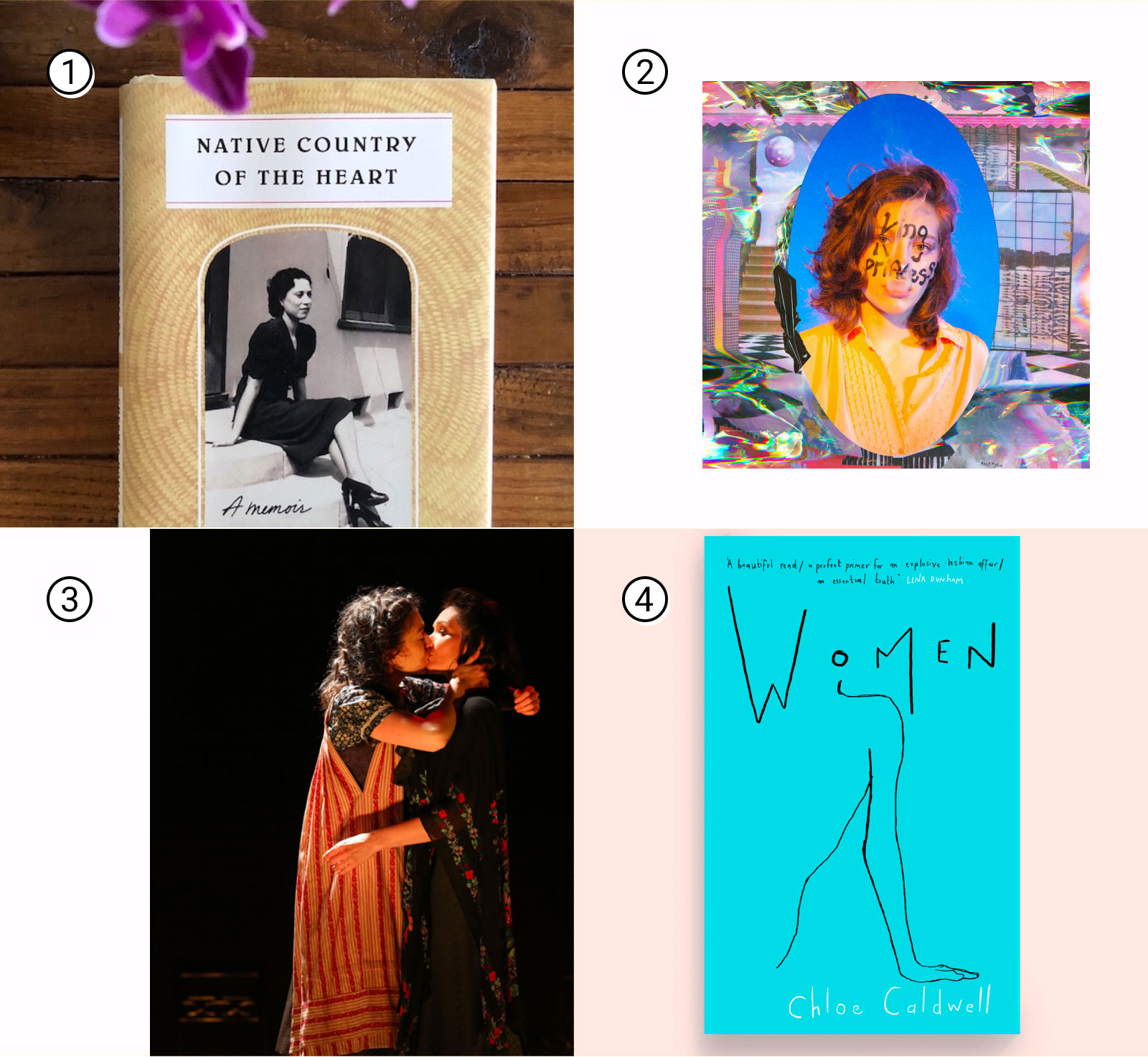
The cornerstone of my own Lesbian Canon is Cherríe Moraga’s memoir Native Country of the Heart, an incredibly moving exploration of memory, family history, Mexican-American identity, and queerness. I don’t think I’ve ever read something that resonated with all parts of my identity so fully — I had to stop myself from underlining parts of it for fear I’d end up underlining whole pages at a time. Fun Home, both the graphic novel and musical, which held me through the fear and thrill of coming out to myself. (“Am I falling into nothingness or flying into something so sublime?”) Indecent by Paula Vogel which tells, among other stories, the story of the first lesbian kiss ever staged on Broadway. I’ll add Fingersmith to this list despite never having read the novel because I saw a staged adaptation in 2015 that I think about near-constantly. Laura Aguilar’s Latina Lesbian photo series, which I learned about on this very website and now hold very dear. The King Princess Make My Bed EP for the messy romances. The film Princess Cyd, which shows such immense tenderness towards its characters that it made me want to approach my own life more gently. Grey’s Anatomy and Jane the Virgin, my beautiful and imperfect soap operas. Oh! Lesbian meme accounts, because I am nothing if not Online.
It took a pretty long time for me to be comfortable calling myself a lesbian and on my way to living and loving that label, two pieces of art were extremely formative for me: 1) Chloe Caldwell’s novella Women, which I read for the first time while finally attempting to get over my first girlfriend after three very dramatic years and still reread every time I fall in love or get my heart broken and 2) the MTV television show Faking It, the first show I ever watched for the explicit purpose of watching two girls kiss, and which led me to Autostraddle for the first time ever when I was desperately searching for any writing about the show and all of the feelings it was making me feel.
I feel like there’s still so much Lesbian Art that I haven’t experienced and I guess my hope is that so much new Lesbian Art continues to be made that the list always feels a little overwhelming to me. Personally, I’d love to see more big queer films that aren’t historical but mostly I’d just love to see more. More lesbian representation of any and all kinds, really, but here are some ideas off the top of my head: sober lesbians, lesbians who are older and happily married, lesbians who have other queer friends, lesbians of color trying to figure out their lives, lesbians with queer siblings!
Al(aina), Writer
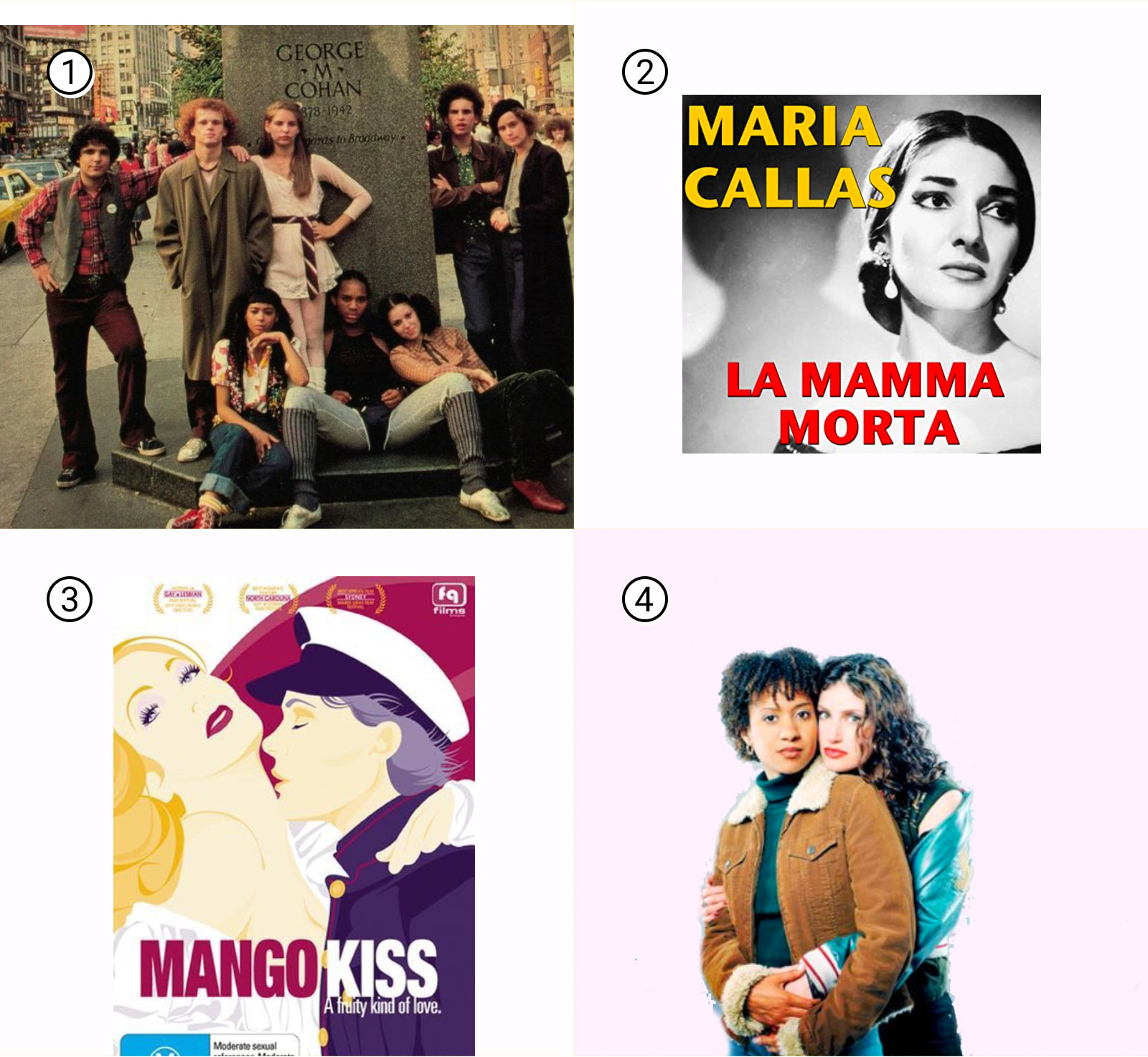
I always say I was raised as a lesbian by gay men, and so I feel like my lesbian canon is heavily influenced by gay men’s culture, and specifically, camp, in its Sontagian meaning. Like, not only did I come out while attending a performing arts high school, my best friends were opera majors. When I think about the art that formed me as a lesbian, it was Maria Callas singing “La Mamma Morta”, or Leontyne Price’s very specific shift in voice during “My Man’s Gone Now“. I watched Fame kind of as a guidebook? Okay and also, Rent, obviously. Noah’s Arc, was a huge, huge, huge, huge show for me. I remember watching it during mandatory visits to my father at 2 am on Logo. But also like, Feldenkrais movement training feels like a huge part of my lesbian canon. And art songs by Clara Schumann. Yoga before 9 am. The film Mango Kisses plays a very specific role in my development as a submissive. And if we really wanna stretch, American Girl Magazine and the historical dolls, specifically (in order of lesbian influence) Felicity, Addy, and Samantha.
I guess, obviously, most of these things are very white. I would like to see less white people and more Black people, specifically. More Black people in stud/femme relationships. More black people in stud/femme relationships who are both dark skinned and fat and poor. You know? Like, Pariah felt so close to home for me, and I also hated it because it was so sad. Beautiful film, perfect film, but I hated it. I don’t want the media that feels closest to home to also be things that I want to watch once and then never again, you know? There’s also something that I’m not quite able to articulate that drew me to culture typically associate with gay men, and I’m honestly not sure what it is! But like, more of that, but for lesbians. I guess Fun Home saved musical theatre, so now 15 year old lesbians can choose that in Musical Theatre Audition Songs classes, which is great, but more. We can always use more.




